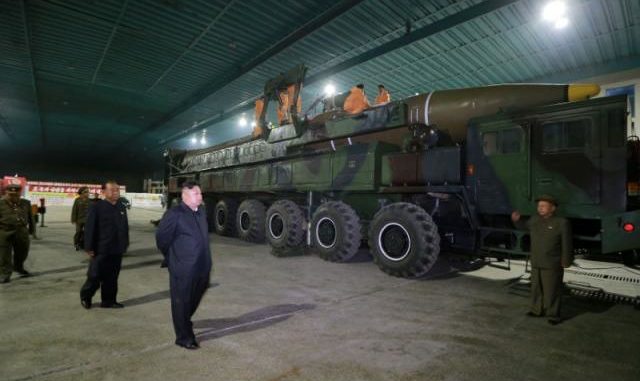
Not everybody asserts as confidently as the Pentagon that the U.S. military can defend the United States from the growing threat posed by North Korea’s intercontinental ballistic missile capability.
Pyongyang’s first test on Tuesday of an ICBM with a potential to strike the state of Alaska has raised the question: How capable is the U.S. military of knocking down an incoming missile or barrage of missiles?
Briefing reporters on Wednesday, Pentagon spokesman Navy Captain Jeff Davis said: “We do have confidence in our ability to defend against the limited threat, the nascent threat that is there.”
Davis cited a successful test in May in which a U.S.-based missile interceptor knocked down a simulated incoming North Korean ICBM. But he acknowledged the test program’s track program was not perfect.
“It’s something we have mixed results on. But we also have an ability to shoot more than one interceptor,” Davis said.
An internal memo seen by Reuters also showed that the Pentagon upgraded its assessment of U.S. defenses after the May test.
Despite hundreds of billions of dollars spent on a multi-layered missile defense system, the United States may not be able to seal itself off entirely from a North Korean intercontinental ballistic missile attack.
Experts caution that U.S. missile defenses are now geared to shooting down one, or perhaps a small number of basic, incoming missiles. Were North Korea’s technology and production to keep advancing, U.S. defenses could be overwhelmed unless they keep pace with the threat.
“Over the next four years, the United States has to increase its current capacity of our deployed systems, aggressively push for more and faster deployment,” said Riki Ellison, founder of the Missile Defense Advocacy Alliance.
MIXED RESULTS
The test records of the U.S. Missile Defense Agency (MDA), charged with the mission to develop, test and field a ballistic missile defense system, also show mixed results.
MDA systems have multiple layers and ranges and use sensors in space at sea and on land that altogether form a defense for different U.S. regions and territories.
One component, the Ground-based Midcourse Defense system (GMD), demonstrated a success rate just above 55 percent. A second component, the Aegis system deployed aboard U.S. Navy ships and on land, had about an 83 percent success rate, according to the agency.
A third, the Terminal High Altitude Area Defense, or THAAD, anti-missile system, has a 100 percent success rate in 13 tests conducted since 2006, according to the MDA.
Lockheed Martin Corp is the prime contractor for THAAD and Aegis. Boeing Co is the lead contractor for GMD.
Since President Ronald Reagan’s administration in the 1980s, the U.S. government has spent more than $200 billion to develop and field a range of ballistic missile defense systems ranging from satellite detection to the sea-based Aegis system, according to the Congressional Research Service.
Funding for MDA was on average $8.12 billion during President Barack Obama’s administration that ended on Jan. 20. President Donald Trump has requested $7.8 billion for fiscal year 2018.
‘ANOTHER YEAR OR TWO’
Last month, Vice Admiral James Syring, then director of the Missile Defense Agency, told a congressional panel that North Korean advancements in the past six months had caused him great concern.
U.S.-based missile expert John Schilling, a contributor to the Washington-based North Korea monitoring project 38 North said the pace of North Korea’s missile development was quicker than expected.
“However, it will probably require another year or two of development before this missile can reliably and accurately hit high-value continental U.S. targets, particularly if fired under wartime conditions,” he said.
Michael Elleman, a fellow for Missile Defence at the International Institute for Strategic Studies, said that although North Korea was several steps from creating a dependable ICBM, “There are absolutely no guarantees” the United States can protect itself.
In missile defense, “Even if it had a test record of 100 percent, there are no guarantees.”
Source : Reuters

THE ROTTEN FISH: CAN OF WORMS OPENED OF APC & TINUBU'S GOVERNMENT OVER NIGERIA'S ECONOMIC DOWNTURN
WATCH THE CRITICAL ANALYSIS AND KNOW THE RESPONSIBLE PARTIES TO BLAME FOR NIGERIA'S ECONOMIC CHALLENGES, WHILE CITIZENS ENDURE SEVERE HARDSHIPS.Watch this episode of ISSUES IN THE NEWS on 9News Nigeria featuring Peter Obi's Special Adviser, Dr Katch Ononuju, 9News Nigeria Publisher, Obinna Ejianya and Tinubu Support Group Leader, McHezekiah Eherechi
The economic crisis and hardship in Nigeria are parts of the discussion.
Watch, leave your comments, and share to create more awareness on this issue.
#9NewsNigeria #Nigeria #issuesInTheNews #politics #tinubu THE ROTTEN FISH: CAN OF WORMS OPENED ...
DON'T FORGET TO SUBSCRIBE AND LEAVE YOUR COMMENTS FOR SUBSEQUENT UPDATES
#9newsnigeria #economia #economy #nigeria #government @9newsng
www.9newsng.com
